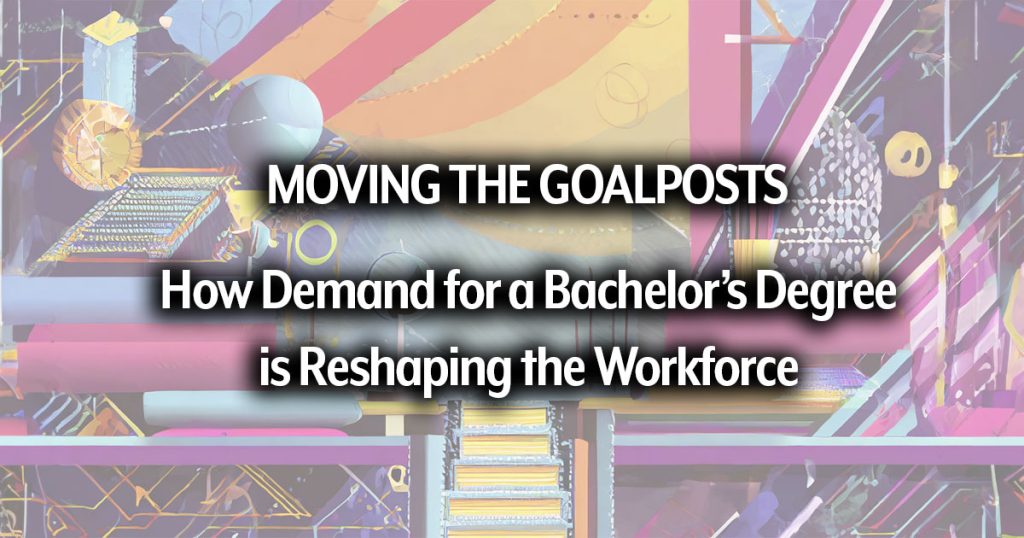The modern job market is changing fast. Employers now demand higher educational qualifications for roles that once required less formal education.
The study “Moving the Goalposts” by Burning Glass Technologies explores the trend towards higher qualifications. It shows how the demand for bachelor’s degrees is reshaping the American workforce.
This shift, known as “upcredentialing,” has major implications. It alters career pathways and impacts workforce dynamics.
Study Overview and Methodology
Burning Glass Technologies used a robust methodology. They gathered millions of job postings daily from over 40,000 websites. These postings were mined for specific requirements like educational qualifications and skills.
The study compared the education levels of current workers with those demanded by employers for new hires. This comparison identified the “credentials gap.” The focus was on roles where between 25% and 75% of job postings call for a bachelor’s degree.
How to Cite the Study
When referencing the findings, use this format: Burning Glass Technologies. (2014). Moving the Goalposts: How Demand for a Bachelor’s Degree is Reshaping the Workforce. Retrieved from https://lerna.courses/wp-content/uploads/Moving_the_Goalposts.pdf
Key Observations and Findings

Upcredentialing in the workforce (Page 1)
Employers are increasingly requiring bachelor’s degrees for roles that traditionally did not need them. This is “upcredentialing.” It has led to a significant “credentials gap.”
Upcredentialing reflects a major shift in hiring practices. Employers now seek more educated candidates, even for jobs that haven’t changed much. This gap between current worker qualifications and new job demands is growing.
Impact on the U.S. workforce (Page 1)
Nearly two-thirds of the U.S. workforce does not have a bachelor’s degree. This makes it difficult for many workers to qualify for jobs that now require higher education levels.
The lack of a bachelor’s degree limits job opportunities. Workers without degrees face barriers to entry in many fields. This trend could impact their long-term career prospects.
Marketing job ads preferences (Page 3)
In a survey of 286,000 marketing job ads, 89% preferred candidates with a bachelor’s degree. This shows the growing preference for higher educational credentials.
Marketing roles now demand more from candidates. Despite the skills not changing much, employers prefer degree holders. This preference highlights the shift in hiring standards.
Credentials gap in administrative roles (Page 2)
65% of job postings for Executive Secretaries and Executive Assistants require a bachelor’s degree. However, only 19% of those currently employed in these roles have such degrees.
This gap is striking. It shows how hiring standards have changed. Many current employees would not qualify for their own jobs if they applied today.
Hiring difficulties due to higher credential requirements (Page 3)
Positions requiring a bachelor’s degree take longer to fill. For example, construction supervisor roles with degree requirements take 61 days to fill, compared to 28 days for those without.
Higher credential requirements can slow down hiring. Employers struggle to find qualified candidates. This delay can impact business operations and productivity.
Degree inflation’s broader impact (Page 3)
The preference for bachelor’s degrees makes positions harder to fill. It reduces accessibility to middle-skill career pathways for those without a degree. This impacts long-term career advancement.
Degree inflation narrows job opportunities. It excludes many capable workers from middle-skill roles. This trend could worsen workforce shortages in some industries.
Certification as an alternative (Page 5)
Occupations with strong certification and licensure standards show less evidence of upcredentialing. Developing industry-recognised certifications could provide alternative pathways to employment.
Certifications can mitigate the need for degrees. They offer a way to demonstrate skills and qualifications. This can help maintain opportunities for middle-skill workers.
Upcredentialing in IT help desk roles (Page 14)
There is a 21% credentials gap for IT help desk positions. 60% of new job postings require a bachelor’s degree, even though the job skills have not changed.
IT help desk roles highlight the upcredentialing trend. The demand for degrees does not match the job’s skill requirements. This suggests employers use degrees as a broad filter.
Salary implications (Page 9)
Jobs requiring higher credentials tend to offer higher salaries. Office and administrative positions have seen significant salary increases due to higher educational requirements.
Higher credentials lead to better pay. This trend reflects the value employers place on education. It also highlights the economic benefits of upcredentialing for those who meet the new standards.
Changing job complexity (Page 12)
In some cases, job complexity has increased, justifying higher education requirements. For example, drafters are now often required to have bachelor’s-level credentials due to advanced skills needed in their roles.
Technological advancements drive upcredentialing. As jobs become more complex, higher education is needed. This is evident in fields like drafting, where new skills are essential.
Aging workforce and replacement challenges (Page 10)
Higher qualification requirements could exacerbate workforce replacement challenges due to an aging population. Occupations like executive secretaries and production supervisors have older workforces that will need replacements as workers retire.
The aging workforce faces new hurdles. Higher degree requirements make it hard to replace retiring workers. This could lead to labor shortages in key sectors.
Importance of alignment between education and employment (Page 3)
Better alignment between K-12 education, job training programs, and employers could reduce reliance on bachelor’s degrees. This could help bridge the credentials gap.
Educational alignment is crucial. It can ensure that workers have the skills needed without necessarily having degrees. This approach could alleviate some of the pressures of upcredentialing.
Details of Data, Statistics, and Findings

For more detailed insights and data, access the full PDF document.
These findings highlight significant shifts in educational requirements. They underscore the need to adapt educational and certification pathways to meet evolving workforce demands.
Other Titles by Burning Glass
The Permanent Detour: Underemployment’s Long-Term Effects on the Careers of College Grads by Burning Glass Technologies and the Strada Institute for the Future of Work. This report examines the lasting impact of underemployment on college graduates, highlighting how initial job placements can influence long-term career success. It provides data-driven insights and recommendations for educational institutions, employers, and policymakers to address underemployment. Download the PDF for detailed findings and actionable steps.
State of Cybersecurity Hiring by Burning Glass Technologies. This report analyzes the cybersecurity job market, highlighting rapid job growth, high demand for skills, and challenges in filling roles. It covers education and certification requirements, emerging skills, and industry-specific needs. Download the PDF for detailed insights.
